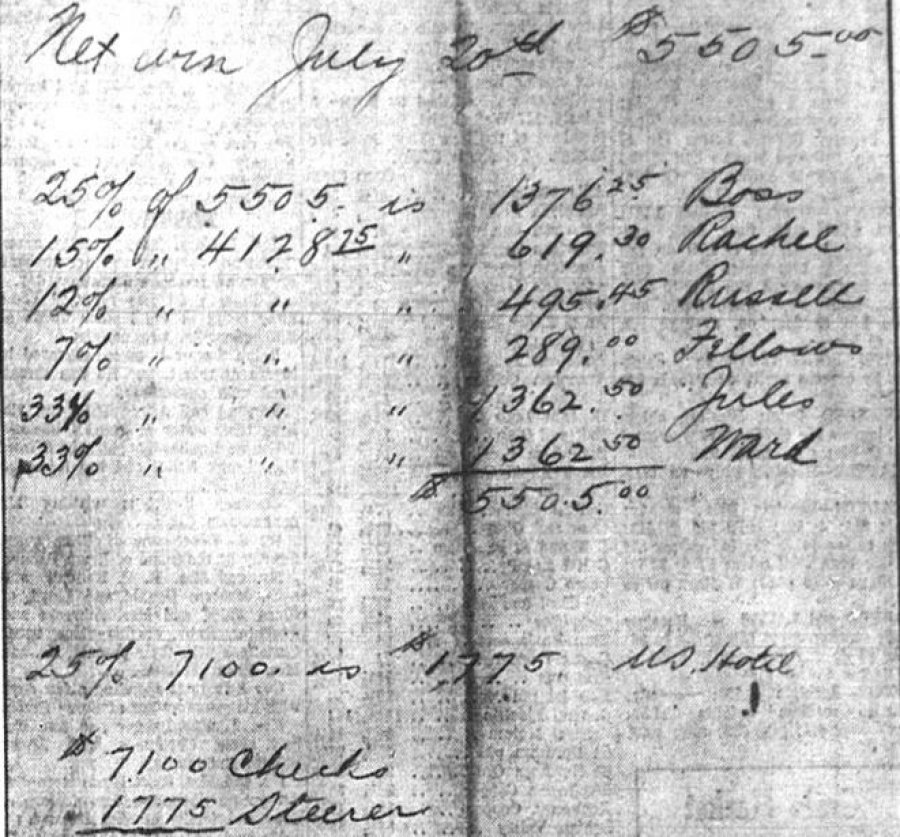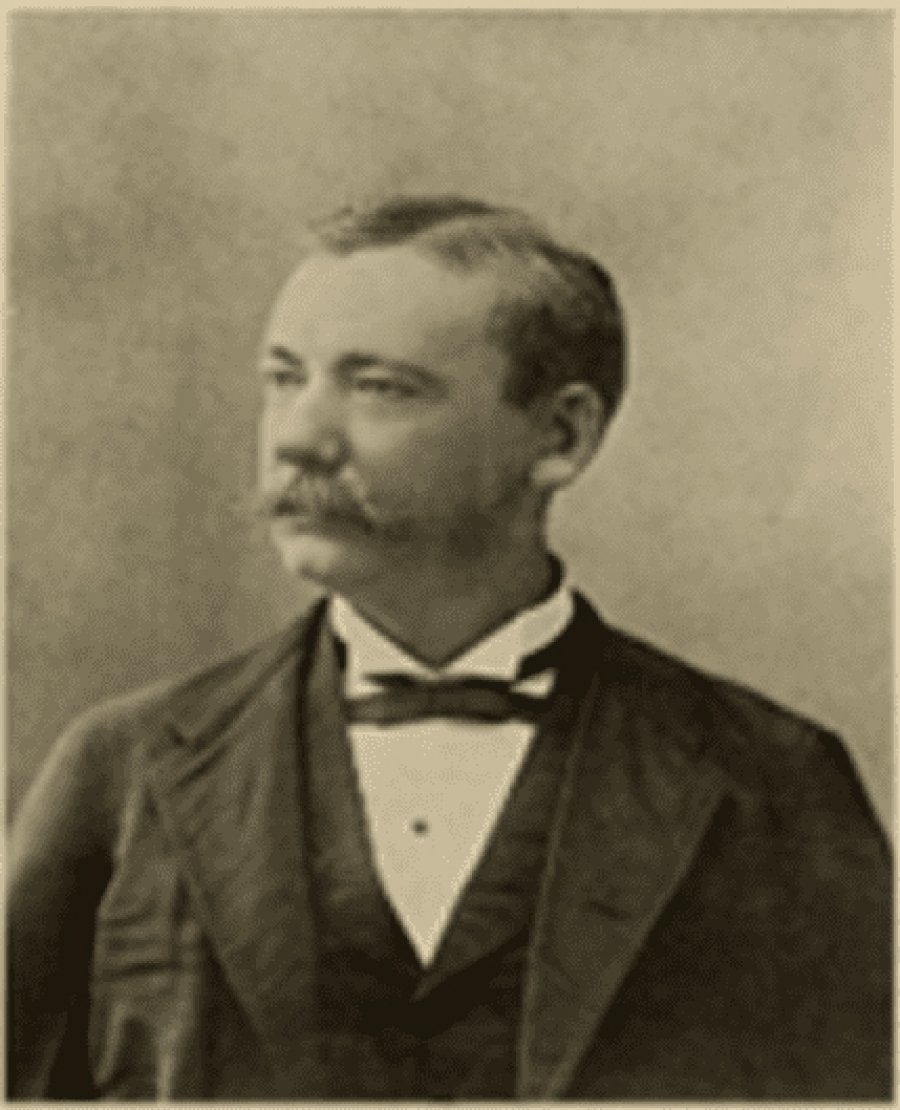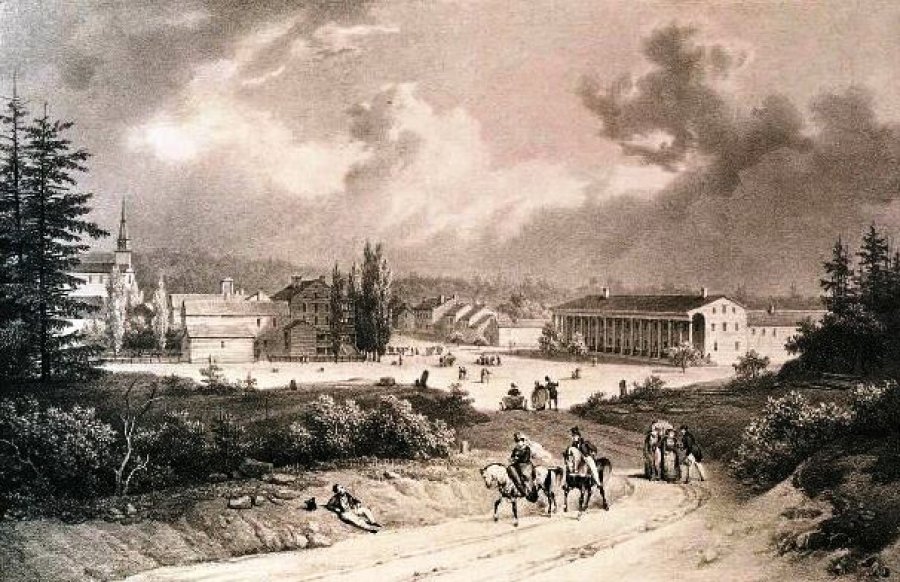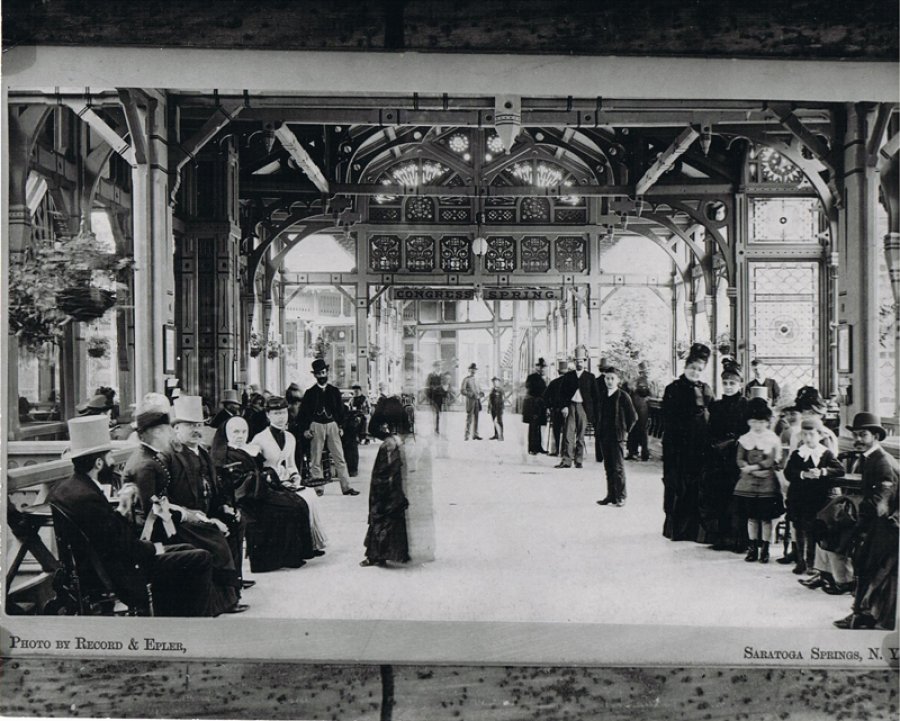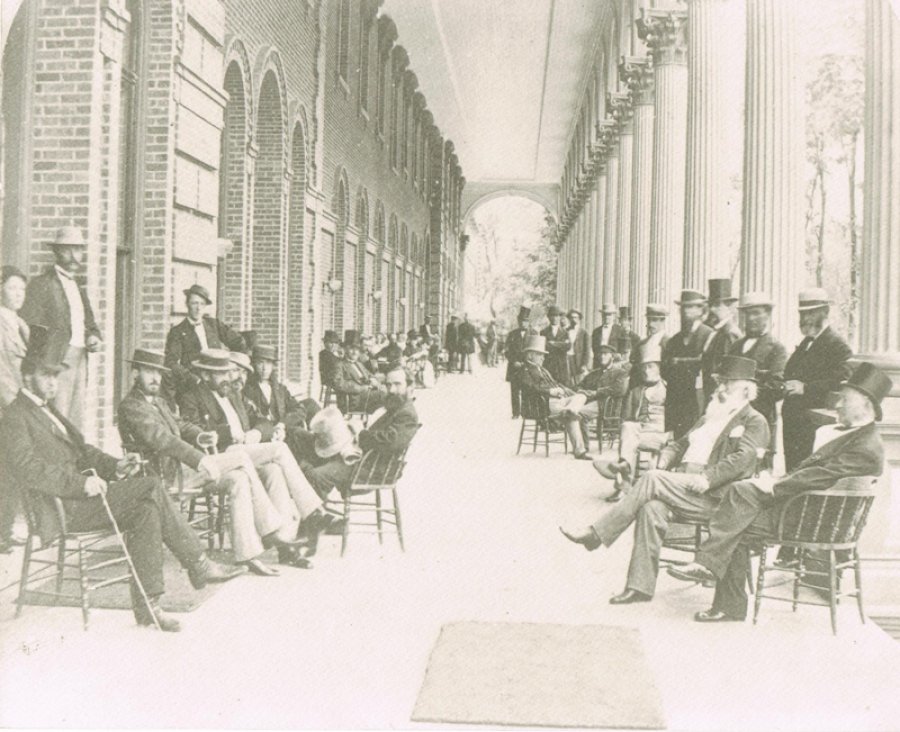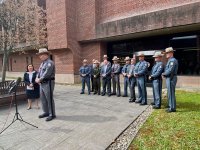Displaying items by tag: history
The 1921 Trial of District Attorney Charles Andrus
On May 11, 1921, Saratoga County District Attorney Charles Andrus stood before Justice Henry Borst at the courthouse in Ballston Spa for the start of a criminal trial. It must have been a strange feeling that day for Andrus because unlike countless other times before the court, this time the District Attorney was seated at the defendant’s table. He had been indicted on charges of neglect of duty, bribery, and corruption. His trial would be extraordinary on many levels.
To begin with, Andrus was being prosecuted by Special Deputy Attorney General Wyman Bascom, appointed by Governor Alfred Smith. Bascom was assisted by former New York State Senator and longtime republican power broker in Saratoga, Edgar T. Brackett. Brackett had once been the attorney for the “Prince of the Gamblers,” Richard Canfield. He was now firmly in the anti- gambling camp and a bitter political enemy of Andrus.
Andrus was defended by attorney William Fallon. Known as “The Great Mouthpiece,” Fallon specialized in obtaining acquittals for his clients (usually through bribing jurors) and was the attorney for the notorious gangster Arnold Rothstein.
Among the witnesses against Andrus were low-level gamblers and associates of Arnold Rothstein, Cornelius Fellows and Benny Russell who both were partners of Rothstein in the gambling at the Arrowhead Inn near Saratoga Lake.
Fellows and Russell, along with a local man named Jules Formel and a New York City gambler named John Ward were partners in a gambling venture with Rachel Brown at 210 South Broadway in Saratoga Springs in July 1919. After spending the summer of 1919 gambling in Saratoga Springs, Rachel Brown headed over to Chicago and got mixed up in the notorious “Black Sox” Scandal in which several Rothstein associates, including Brown, were indicted for trying to fix the World Series.
On July 27, 1919, the game at 210 South Broadway had been raided by police. The following afternoon, Rachel Brown and his friends made a trip to the police station and stole the evidence from one of the jail cells with the help of police sergeant Edward Carroll. Three weeks later, police raided another game on Circular Street and seized back some of the evidence that had been stolen from them. Within six months, Sergeant Carroll was promoted to Chief of Police. All this prompted Governor Smith to appoint Bascom and his investigation led to the charges against Andrus who was apparently mixed up with the gamblers at 210 South Broadway.
During the trial of District Attorney Andrus, John Ward testified that he, Formel, and Russell had met with Andrus in the spring of 1919 and had received approval from the District Attorney to open up. He further stated that Andrus had been paid over $2500 in protection money for the gambling at 210 South Broadway during the summer of 1919 before the raids put an end to the operation.
Wyman Bascom attempted to introduce a ledger into evidence that showed the payoff for one night’s gambling at 210 South Broadway. Ward did not need the paper to explain the payoff system. The top line showed that twenty-five percent of the night’s take was to be given to “The Boss.” The remaining split of the profits was; thirty-three percent each to himself and Formel, fifteen percent to Rachel Brown, twelve percent to Russell and seven percent to Fellows.
Other witnesses testified that Andrus was upset that Formel had made $3800 in payoffs but still owed $4000 and therefore had orchestrated the raids in 1919 and that Brown once held up $4300 and yelled “This is for the District Attorney!” in a crowded gambling den. Andrus had negotiated a settlement between Russell and Formel when Russell backed out of the plan, and open gambling had been allowed by the District Attorney in no less than fifteen places throughout the city, including one practically next door to Andrus’ office on Broadway.
Andrus never took the stand to deny the specific allegations and his lawyers never bothered to deny them either. Rather, the defense merely claimed that it was the job of the police to make arrests, not the District Attorney, and that the whole investigation was politically motivated.
Despite all the evidence to the contrary, the jury returned the verdict on May 17, 1921. By a vote of 11-1, NOT GUILTY!
In response to the good news, some of Andrus’ supporters rioted in celebration. Racing up and down Broadway, pulling fire alarms, vandalizing the porches of citizens who supported the prosecution, and lighting a fire on the front lawn of Senator Brackett while breaking out the windows of his home. In true Saratoga fashion, seven months after his acquittal, Charles Andrus was re-elected to the office of District Attorney for Saratoga County.
Major Calvin W. Preston of Galway: Soldier & Hurricane Survivor
On the sunny morning of October 21, 1861 – to cheers from tens of thousands of citizens, with bands playing and the roar of cannons - Calvin W. Preston, Galway farmboy boarded a towboat-drawn barge at the Albany, NY docks with other soldiers of the Ellsworth Avengers regiment for the beginning of a dangerous and arduous journey that would lead to perhaps the most important battle of the Civil War: Gettysburg.
Born on February 28, 1845, he was the fifth son of Dr. and Mrs. Calvin Preston. The Prestons, originally from Antwerp, NY were attracted to Galway by family connections and the potential for a thriving medical practice. They settled on East St. in the 1830s where they built a six bedroom home and raised a large family.
Caught up in the furor over the death of Elmer Ellsworth, Mechanicville native, Abraham Lincoln confidant and the first Union soldier to be killed in the Civil war - at age 16 Calvin enlisted in the 44th New York State Volunteer Infantry Regiment, aka Ellsworth Avengers on September 2, 1861 as a drummer. He was active in General George McCellan’s ill-fated Peninsula Campaign, a failed attempt to occupy Richmond, Va. - capital of the Confederacy. At the campaign’s end he contracted dysentery, was sent home for the “Northern Cure” returning to his regiment in time to participate in the Battle of Gettysburg. In the aftermath he assisted in the care of the wounded and the seemingly endless task of burial of the dead.
Mustered out on October 11, 1864, he trained as a druggist and in 1866 joined his brother James, who had served in the Confederate Army, in Galveston, Texas. Four years later James passed away under mysterious circumstances and shortly afterward Calvin married his widow. Calvin became a prominent citizen of Galveston operating a drug store at a location in the business district referred to as Preston Corner, was a high ranking member of the Free Masons and Texas Society- Sons of the American Revolution, and a member of the Texas Volunteer Guard with the position of Major and Inspector General.
On September 8, 1900 with no advance warning a hurricane passed through Galveston. Looked upon initially as routine flooding in a city whose maximum elevation was 8 feet above normal high tide 8000 lives were lost; it remains the worst natural disaster in US history.
Calvin responded heroically in the rescue of his family, wading home from his office as conditions worsened, managing to borrow a rowboat along the way. Upon arrival he found them standing on the dining room table. Crowding them into the boat he pushed it through shoulder deep water to the nearby Rosenberg School, a 3 story, massive stone and concrete structure, with wind gusting to over 100 MPH.
The night spent there was not a comfortable one as the level 4 hurricane buffeted the structure with wind gusts of up to 180 MPH and a storm tide of 15-20 feet. To make matters worse a lightning strike caused the internal collapse of a chimney flue, resulting in deaths of people huddled below.
Disposal of bodies was an overwhelming task, a description better left to other historical accounts. The effort to rebuild Galveston after the storm took several years and included the construction of a 17 foot high seawall to prevent future storm related disasters.
For Calvin the aftermath was too much to bear, the memory of similar carnage and loss of life at Gettysburg still clear in his mind. Two of his brothers – William and Platt – wealthy mill owners in Waitsburg, Washington invited him and his family to move there, providing him with a job in one of their businesses. He again prospered and was elected mayor of the city. His untimely death came 5 years later due to pleurisy.
Well liked and respected, the homage to him at the funeral service concluded with the words of William Shakespeare:
His life was gentle and the elements so mixed in him that nature might stand up and say to all the world, “this was a man.”
The Death of Gideon Putnam
December 1, 1812 was the date on which the founding father of Saratoga Springs, Gideon Putnam, died.
Gideon and his wife Doanda Putnam were probably the most influential couple in the formation of our great city. Gideon was originally from Sutton, Massachusetts, while Doanda was from Connecticut. Shortly after their marriage in 1787, the two began to strike out for a new beginning in Vermont and then on to the Saratoga Lake area. None of those locations worked for them until they moved to Saratoga Springs in 1789 and it all seemed to fit.
Gideon and Doanda came to the Saratoga Springs area and found a region with vast pine forests. Gideon realized that those trees could be turned into lumber to feed the need for building materials in this new developing village. Gideon began to also realize that the naturally occurring mineral springs would be a draw for large numbers of summer visitors, but the area lacked the required accommodations to support these tourists.
In 1802 the Putnams are credited with building the first hotel in the village, called Putnam’s Tavern and Boarding House. Located on Broadway, a few steps away from the Congress Spring, the hotel was an immediate success with visitors coming to the springs. The Putnams offered comfortable accommodations, good food and drink for their guests. Putnam made improvements to the Congress Spring and then later to the Columbia Spring, for easier use by those looking for a cure for their ailments by taking the waters. Gideon’s success in business was shared with the young village as he donated land for a cemetery, church and school to help plan for a great future community.
Gideon felt so strongly about the efficacy of the waters that he published a set of guidelines for the “Proper use of the springs.” He set forth clear rules that were intended to not pollute the springs as well as making the water forever free at the spring. This simple rule of free water at the spring set the tone for this rapidly developing resort destination. Owners of the mineral springs could not charge to drink at the spring and therefore could only make money by offering baths and bottling the waters for widespread distribution. In time Saratoga Springs would become the number one tourist destination in the United States during the 1800’s.
Putnam’s Tavern and Boarding House was such a success that Gideon and Doanda bought more land and began laying out many of our streets including our beautiful Broadway and adding to the size of their boarding house. By 1811 the Putnams realized that it would be a logical plan to build another hotel across the street, also on Broadway. As construction started, they decided to name the new hotel Congress Hall, after the Congress Spring. By this time the spring, a short walk away, was so famous with visitors that he thought this would help in future promotions for the hotel.
During construction of the Congress Hall, Gideon fell from the north end of the piazza and was severely injured. Gideon lingered for many months and eventually succumbed to those injuries on December 1, 1812. Even though Gideon had passed, his wife and family continued to run their businesses as well as their hotels for many years until 1864. Gideon may have died in 1812 but his idea to allow for free mineral water at the springs and plan for a successful resort city still continues today as Saratoga Springs attracts thousands of visitors a year and our mineral springs continue to be free every day.
Charlie Kuenzel taught at Saratoga High School for 36 years and was co-owner of Saratoga Tours LLC for 19 years. Author, lecturer and currently President of Saratoga Springs History Museum, Charlie loves Saratoga History and can be reached at This email address is being protected from spambots. You need JavaScript enabled to view it.
Birth of the Boy Scouts - 110 Years Old this Month
W.D. Boyce, a wealthy Chicago publisher, encountered a Boy Scout while lost in London. Impressed by the Scout’s “Good Turn,” Mr. Boyce returned to the U.S.A. chartering the name “Boy Scouts of America” (BSA) in February 1910. Mr. Boyce never formed a unit nor enlisted a youth in his movement.
Edgar M. Robinson, Boys Work Secretary of the International Committee of the YMCA, oversaw all YMCA youth programs and summer camps in the U.S. and Canada. Mr. Robinson travelled to Chicago to meet with Mr. Boyce in May 1910. Mr. Robinson, a quiet, charming man, not particularly charismatic, but a man of vision and substantial organizational skills, convinced Mr. Boyce to allow the YMCA to serve as the organizational arm of the BSA.
Mr. Robinson contacted the heads of all youth (boys) organizations and convinced most to reorganize under the auspices of the BSA. The national office of the Boy Scouts of America opened in New York City on June 1, 1910. The first Boy Scout summer camp was held at the YMCA’s Silver Bay on Lake George that summer.
In September 1910, J.C. Smith, Boys Work Secretary in charge of youth programs at the Saratoga Spa YMCA, travelled to New York City to attend a meeting at the Waldorf Astoria. There, Smith heard presentations by General Baden Powell, Dan Beard and others, and received his appointment as a Scoutmaster. Upon his return, Smith organized a “Patrol” of Scouts at the Saratoga YMCA.
Smith announced the first nine youth members of the Patrol on Oct. 12, 1910. Because the YMCA was a Protestant organization, many early Patrols were formed at local YMCA’s or Protestant churches across the country.
Patrols also began in Mechanicville (sponsored by First Presbyterian Church), on Dec. 17, 1910; in Schuylerville, on July 13, 1911; in Corinth, on Oct. 18, 1911; and in Saratoga Springs (First Baptist Church) on Oct. 24, 1911.
Initially, each city or village operated as its own Council. The “Saratoga County Council” was founded in 1924. Troop 1 Ballston Spa, chartered to the Ballston Spa United Methodist Church in 1913, is the longest continuously operating Troop in Saratoga County.
Author Gene Phillips joined the Boy Scouts as a Charter youth member of Pack 24 Wilton in 1955. During more than 40 years in scouting, Phillips has served as Cub Scout Committee Chair, Scoutmaster, Sea Scout Skipper, Training Chair and Advancement Chair for the Saratoga District of Twin Rivers Council.
He is currently completing a book on the History of Scouting in Saratoga County, which includes a pictorial of all known memorabilia (patches, neckerchiefs, etc.) issued by Saratoga County Council (District). Gene is an Eagle Scout (Troop 24 Wilton), as is his son Keith (Troop 24), and grandson Ethan (Troop 2 Ballston Spa). Gene Phillips can be reached at This email address is being protected from spambots. You need JavaScript enabled to view it.. Gene’s article on the history of the BSA was recently featured by the Saratoga County History Roundtable. For more information, email This email address is being protected from spambots. You need JavaScript enabled to view it..
A Gangster’s Paradise
Former City Police Chief Pens Historical Book About Saratoga’s Notorious Gangsters & Gamblers
SARATOGA SPRINGS — Former city Police Chief Greg Veitch has published a new book that documents the history of Saratoga gangsters and concludes in the 1950s - when 130 years of open illegal gambling in the city came to an end. The argument could be made that along with other mid-20th century events, such as the construction of the Northway and the sweeping project of Urban Renewal, going “legit” in a post-gangster Saratoga Springs contributed to the development of the prosperous city that exists in the present day.
Veitch, whose family has resided in the Spa City for several generations, served in local law enforcement for a quarter-century, rising through the ranks to become Saratoga Springs’ police chief. Tuned in to a calling that insisted there were other things to do in his life, Veitch resigned his position as police chief in May.
“Things have been good. I don’t miss it as much as I thought I would, but I felt called to go into the profession and I felt called to leave, so maybe that has made it easier,” he said, during a sit-down interview this week. “I don’t necessarily know what the future holds for me, but I was prepared to leave. In my life, I try to follow what I believe I’m hearing from above.”
One of the things he has worked on is continuing to historically document notorious gangster connections with the village and the city of Saratoga Springs during a period that spanned more than a century.
His previously published debut book, “All the Law in the World Won’t Stop Them,” retells the history of the gamblers and gangsters of Saratoga from the early years as a village up through 1930. The new edition, published by Shires Press, continues the history of Saratoga gamblers and gangsters with tales of bootlegging and liquor raids, gangland shootouts, political payoffs and police corruption.
The new book, “A Gangster’s Paradise: Saratoga Springs from Prohibition to Kefauver,” tells the story from the Prohibition Era t
o the Kefauver Committee hearings in the 1950s. In May 1950, the Senate established a five-member Special Committee to Investigate Organized Crime in Interstate Commerce. Tennessee senator Estes Kefauver was selected as its chairman.
“My intent was always to write the story from the beginning of the village through the early ‘50s when the Kefauver investigation put an end to the open gambling in Saratoga, to tell the story from beginning to end,” Veitch said.
“How did the book thing get started? When I was a little kid, 4 or 5 years old, The Veitch family had a reunion when we were selling the Old Bryan Inn. I can remember the older guys – my uncles and my father, telling me this story about my great-grandfather Sid and a mafia shooting, or a gangland shooting,” Veitch said. “It was about this guy who got shot and dumped at the hospital. When the police came and interviewed Sid about it, he said, ‘Look I was sitting in the front seat of the car. They shot the guy in the back seat of the car, so I didn’t see ‘nothing, I can’t help you.’
“Now great grandpa Sid was kind of a rough-and-tumble guy, so the story’s believable. For years the only thing I knew about him was that story, and nothing else,” Veitch said. “So, I go away to college, I come back; I become a policeman and I get promoted to be a detective lieutenant and a detective calls me up out of the blue one day and says: hey, can you go check on a case from the 1980s?”
While searching through the archives he discovered some information about the case he had heard about as a child. “The murder of Adam Parillo 1936. It was one sheet. My great-grandfather is not mentioned at all. He’s not part of the story in any way. And (Parillo) probably wasn’t even shot in the car. My great-grandfather probably just told people that to make himself look tough,” Veitch said.
Nonetheless, he pulled together some newspaper clippings regarding the Parillo case for a presentation at the Saratoga Springs History Museum.
“It was about the most famous unsolved murder in Saratoga Springs history. When I was done talking, a guy walked up front and said to me, ‘You should write a book.’ Before that, I hadn’t even thought anything about it, but I did know there were other fascinating stories about Saratoga, so I started piecing these stories together,” Veitch said.
During his course of research – which was conducted strictly through historical resources like newspapers and not police files – it dawned on him that what he had was a 130-year story of open gambling and corruption. “Stories about what was going on: fixed horse races, bootleggers shooting at each other on Circular Street, just fascinating. I had so much stuff, I thought, you know, maybe I should write a book; get it down and even if nobody ever reads it, at least there will be a place in the library where somebody can go and look at it,” Veitch said.
“I love telling stories, I love talking to people from Saratoga. I like people stopping me on the street and saying, ‘Hey, my family did this during that time.’ I think I can write a couple of more books (in the future), but it won’t be about this.”
The new book features chapters with titles like “A Spasm of Violence,” “Trouble at The Track,” and “Prohibition at The Spa.” It includes historic photos and research notes.
“A Gangster’s Paradise” sells for $25. It is available at Northshire Bookstore, on Broadway in Saratoga Springs. For more information, go to: gangstersofsaratoga.com.
History of Saratoga - Congress Hall: Putnam’s Vision
The grand hotels of Saratoga Springs, in the 19th century, were the most visible indication that our city was the number one tourist destination in the country. The hotels were huge in size, eloquent in style and known throughout the country as “the place” to be in the summer season. Gideon Putnam built the first hotel in the village in 1802 and it was then known as Putnam’s Tavern and Boarding House. This initial hotel had the capacity to house 70 guests. In 1802 Saratoga Springs was not in need of large hotels because it was a small fledgling destination but as our popularity grew, it didn’t take long before Putnam needed an “overflow” for his first hotel and began to plan and build a new hotel. The new hotel would be called Congress Hall. The Congress would be located on the eastside of Broadway, stretching from the south-east corner of Spring Street to East Congress Street (the entry to Congress Park today).
Gideon Putnam began construction of Congress Hall in 1811 with the name coming from the nearby famed Congress Spring that was a well-known asset in the early village. While working on the north façade of the hotel, Gideon fell from the scaffolding and was seriously injured. Putnam suffered for months from those internal injuries until he died on December 1, 1812. Congress Hall was three stories tall with 196 feet of frontage on Broadway and two wings that went down Spring Street and East Congress Street for a length of sixty feet. The front side of the hotel had 17 columns each thirty feet in height that framed a very beautiful porch that gave guests a place to sit and observe the activity on Broadway day and night. For this period in Saratoga history the Congress was a very large hotel that had a capacity to accommodate 150 guests. Early ownership of the hotel preferred to make this destination a house of temperance and religious activity.
In 1814 the hotel waspurchased by Grandus Van Schoonhoven who worked on the property until 1815 to further match the original plans set forth by Putnam. At this point in city history the Congress Hall was the largest hotel in Saratoga Springs until the United States Hotel was constructed and opened in 1824. Van Schoonhoven was joined in business by his nephew in 1822 and then again joined by others in 1823. In general, the hotel was leased to many different proprietors during the period from 1823-1855. In 1819 the village of Saratoga Springs was declared a special township with the right to self-govern. In that year the town decided to allow certain “pleasures” to be introduced in the village. In the summer of 1819 the Congress Hall introduced billiard rooms, an orchestra for concerts at night and allowed men to play cards in their rooms. These new additions made Congress Hall a desired location for dancing and other flirtation activities of the day. In 1822 Frank Johnson, a prominent band leader, came to provide the music for the dances called “Saratoga Hops” that would continue for years as a much-anticipated event of each season.
After midnight on May 30, 1866 the original Congress Hall burned in a very rapidly spreading fire that also destroyed the nearby Hamilton Spring and Bath House. The management had been working to prepare for the Congress Hall to open for the summer season of 1866 on June 1st. The original hotel was constructed of wood and was very susceptible to catching fire from the many open flame devices used in that time. Henry Hathorn was the owner at the time of the fire and began to immediately make plans to re-build. The new hotel would be constructed of brick and be much larger and grander than the original.
The new larger Congress Hall would be rebuilt in 1868 and would extend 416 feet down Broadway with two right angle wings, 300 feet in length with a rear courtyard in the middle. The entrance to the hotel revealed a lobby with a grand staircase and 16-foot-high ceilings on the first floor. The piazza on the Broadway side was 20 feet in width that would hold countless rocking chairs for guests to rock away the summer days while fueling the gossip of the day. As the new Congress Hall was planned and constructed it was evident that the hotel needed a large ballroom to compete with the other larger hotels in Saratoga Springs. Property that was not part of the original footprint of the hotel needed to be purchased to allow for the ballroom. The needed property would be found on the north side of the intersection of Broadway and Spring Street. The building that would house the ballroom still stands today but is composed of retail on the first floor and condo housing on the floors above. Henry Hathorn connected the hotel to the ballroom with a convenient iron pedestrian bridge, made in Troy NY, that passed over Spring Street. This passage-way allowed women to maintain clean silk shoes and hems of long dresses during inclement weather as they walked above an unpaved Spring Street. The metal bridge was further dressed up with the addition of carpeting, Chinese lanterns and an awning used during rainy weather.
During the summer of 1869 the Congress Hall hotel was prepared to host the first suffrage convention with Susan B. Anthony in attendance. By 1873 the new ballroom allowed the hotel to offer many great forms of entertainment during the summer season featuring Friday night balls with famous orchestras and performers. A travel guide in 1874 defined the Congress Hotel as the spot for American aristocracy to spend their Saratoga summers, that offered no barriers to the mixing of average people to high society. It has been noted by some travel guides, and a few historical accounts, that many felt that during this time that the village of Saratoga Springs taught the average American how to take a refined, civilized vacation. Undoubtedly, Congress Hall provided a location and an atmosphere for that education. As the years went on and the city approached the 1900’s, Congress Hall began to fall from favor with the vacation crowds and went into bankruptcy on May 9, 1904.
Between the summers of 1904 and 1911 many attempts to re-open and re-organize Congress Hall eventually failed. Congress Hall was closed forever and sold to the City of Saratoga Springs in 1911 with demolition to follow. The land on which the hotel stood was added to expand Congress Park and was just a foreshadowing of the eventual demolition that would take down the other two giant hotels, the Grand Union and United States. Vacation styles in America were changing and so would Saratoga Springs as it continued to re-invent itself to remain the “summer place to be.”
History of Saratoga - Geology of the Mineral Springs
To truly understand the beginning of Saratoga Springs as a village you must understand the importance of the mineral springs in our development. A real understanding of the mineral springs is anchored in the understanding of the local geology.
Most people that visit the city today are not huge fans of the taste of the mineral springs when they try them for the first time. Having grown up in Saratoga Springs, my family and I always loved the taste of the springs, but I understand mineral water has a taste that you need to get accustomed to before saying you enjoy it, if ever. In 2019 some people say they only like the spring that dispenses water near the Auto Museum in the Spa State Park. That spring is not an example of a true deep sourced mineral spring in the city but rather a fresh water spring that draws its water from the upper hundred feet of another aquifer.
In order to better understand the deep sourced true mineral springs, we need look at the geologic history and therefore go back millions of years in Earth history. Approximately 490 million years ago the area around Saratoga looked very different than it does today. We were covered by a beautiful tropical ocean basin that became shallower as you traveled to the west toward Galway to eventually form the shoreline of this ocean and as you moved east toward Vermont it got deeper. Mountains further to the west were eroding with streams and rivers bringing sediment from that erosion process to the ocean for deposition. These deposited sediments would eventually harden to make varieties of sedimentary rock that would cover this entre area. Rock types like sandstone, limestone, dolomite, and shale were all deposited over millions of years in very thick layers in the Saratoga area. Most of these sedimentary rock types will hold rain water in their layers and act as a storage system or aquifer in the ground. The last layer to be deposited was a layer of black shale. Shale is a non-porous rock that will act as a protective cap over the other layers below.
This deposition process was stopped when the ocean receded as the area rose in elevation. Over millions of years as tectonic forces in the earth’s crust pushed on the rock layers it caused earthquakes to fracture those rock layers. Those fractures can be found as faults all around Saratoga. A very large fault called the McGregor Fault produced Mt. McGregor and continued south and branched to form the Saratoga Fault which is the main geologic fault running through the city that produced the mineral springs. The Saratoga Fault is categorized as a “normal” geologic fault. To understand a normal fault, picture a large block of material that is under pressure and breaks in the middle to produce two separate pieces. Then picture one of the two pieces rising and the other sinking down relative to the break or crack. This is the shape of a “normal” fault. Now picture Broadway in Saratoga Springs. The break or fault runs the length of the street. The break caused the west side including Broadway to rise and the east side to sink relative to each other. As a result, we see all the streets on the east side of Broadway such as Lake Avenue, Caroline Street, Phila and Spring Streets all go down in elevation from Broadway, therefore go down the face of the fault. This displacement is best seen in the rock cliff found in High Rock Park behind the 9/11 Memorial. Because of this fault all mineral springs are found on the east side of the fault.
This fault provided the break in the rock layers to allow the water trapped in those rock layers to rise to the surface as natural mineral springs. The Mohawk enjoyed the waters from these naturally occurring springs for hundreds of years before European settlers arrived with the technology to drill more mineral springs. By 1900 we had reached an apex in the number of springs in the city of Saratoga Springs with the number at 203. Many of these springs were pumped to extract carbon dioxide gas from the water for use in soda fountains in big cities. This abuse caused many of the original springs in the city to go dry. State laws passed in 1908 restricted the use and number of mineral springs to just 17 today. This restricted number allowed the aquifer over time to build back the necessary ground storage to provide for a stable supply for future use.
Many geologists today have wrestled with the analysis of why the mineral springs of Saratoga Springs are so unique. Our mineral springs are some of the highest naturally carbonated waters found in North American as well as some of the most highly mineralized “cold” water springs on the continent. The problem of carbonation has not been solved. The source of carbon dioxide gas is hotly debated but not resolved. Some claim the gas is from very deep-seated volcanic sources, while some think it’s a chemical process that provides it.
In the area of mineral content, we know heat helps to dissolve material in water as seen in cooking or in “hot springs.” Because our waters are cold and emerge from the ground at a consistent temperature of 52-54 degrees Fahrenheit year-round, that also presents a problem for discussion. While coming to the surface cold, the mineral water brings with it very large amounts of dissolved minerals from the ancient rock layers below. These minerals are what gives the Saratoga mineral springs their unique taste and possible health benefits. Our waters contain trace amounts of iron, iodine, cobalt, lithium, chromium, zinc, calcium and magnesium as well as many electrolytes. Our mineral waters do not contain sulfur in any reasonable amount and therefore cannot be identified as sulfur water.
Yes, our mineral water is unique and probably not in high demand because of its taste, but it helped to supply a need for visitors in the 1800’s. It was mineral water that acted as the spark that brought people to our city and helped it to become the number one resort in the United States in the 19th century.
History of Saratoga - Summer in Saratoga: 1874
A common publication in the 1800’s was the location specific travel guide, that would help visitors traveling to a particular location make the best use of their vacation time. As you can well image, Saratoga Springs had many such guides for visitors since we were a popular destination for summer visitors.
I find it interesting reading these guides because they give us a look back in time as to what was exciting and popular for visitors coming to the city. I recently searched the travel guide titled; “SARATOGA and What Is To Be Seen There.” This guide was written in 1874 by R.F. Dearborn M.D. and sold for $.10 a copy. The first page of this guide proclaims that Saratoga is the “Queen of American Spas.”
In the summer of 1874, the permanent population of the city was about 9,000 people with the number of summer visitors in the tens of thousands. The 1874 guide professes that we can accommodate at least 15,000 visitors in the many grand hotels of the city with an unknown number to be housed in boarding houses and private homes. The guide informs us that; “During August Saratoga is always full, crowded-squeezed.” The description continues with “The streets are thronged with a gay and brilliant multitude, engaged in riding, driving, walking, each enjoying to the utmost a fascinating kind of busy idleness.”
The multitude that visited us, mostly chose to stay in the grand hotels in the Broadway area. The grand hotels all offered the American plan that provided for one price, the room and three enormous meals a day. Since there was keen competition to attract guests to fill the grand hotels those establishments added daily entertainment in the forms of musical concerts, nightly dances and balls, speakers and activities like billiards for those guests. The guide professes that the number one hotel of the day was the Congress Hall. Congress Hall had been re-built in 1868 by H.H. Hathorn, after a fire a few years before had destroyed the original structure. Since this guide went to print before the 1874 season began, I think it is interesting that the Congress was singled out as the number one hotel. In the summer of 1874, the newly renovated Grand Union Hotel would also impress the visitors. The cost of a stay at these hotels varied from about $3.50/day (or higher) to a weekly rate of $21-$30 /week. These numbers are great to compare with hotel rates in the city today and do not include three meals per day.
1874 is an interesting time in our history since it is the last summer that the “Big Four” were in existence in the city. The Big Four were the four largest hotels in the city at the time, Congress Hall, Grand Union, United States, and Grand Central. A fire would break out on October 1, 1874 and quickly destroy the beautiful Grand Central, leaving only three grand hotels from that date.
The 1874 guide defines the best neighborhoods of the city as being the area around the streets of Circular, Lake Avenue and Franklin Street. In 1874 North Broadway was starting early construction and some of the largest houses would be built there and on Union Avenue in the next few years. Broadway is continually mentioned in the guide as a beautiful street not only because of its grand width but also because of the double row of elm trees that provided such needed shade to the many people strolling that thoroughfare on hot summer days.
Many visitors even in 1874, came to Saratoga Springs to try the mineral water. In that year Dr. Whiting, a long-time physician in the city, was considered the expert in the medicinal properties of the springs. Dr. Whiting was like many other physicians in the country that provided patients with a “prescription” or guidance for the proper consumption of the healing waters. The general thought was to drink one or two glasses of mineral water in the morning prior to breakfast. The most popular morning spring was the Congress located in Congress Park. Doctors generally told patients following the consumption of the water, to take a brisk walk. The combination of high mineral content in the water and the physical activity usually made the brisk walk to the nearest bathroom. For many the intestinal cleansing effect was dramatic and welcomed. Some patients were also instructed to drink from a different spring in the afternoon and some even had a third spring added to their routine before retiring in the evening. The guide discusses the virtues of the many mineral springs in the city, but highlights the popular ones, Congress, High Rock, Columbian, Excelsior, and Empire in more detail.
Summer guests traveled to the Spa City several different ways. In the early 1800’s transportation was very slow and hard on the traveler. The railroad would not connect with Saratoga Springs until the summer of 1832. That meant transportation to the city, in the early days, was by stagecoach and sailing ship. Many of the early visitors to our city were from the southern states. They came north in the summer for the social aspects but also to escape the heat and to find clean drinking water. Water borne disease was very common in large southern cities in the early years of the 1800’s and Saratoga mineral water was generally pure and from a deep source that helped to protect that purity.
By the year 1874 transportation to Saratoga had changed for the better. The railroad came to Saratoga in the summer of 1832 and each year more guests used that faster and easier form of transportation. The guide contains two advertisements for steamship companies that provided cheap fast transportation. In that year Citizen’s Line Steamboats from New York traveled the Hudson River and cost $2.50 to travel from Saratoga Springs to New York City. Guests boarded the train in Saratoga to travel to Troy. The train took guests to a steamship that left nightly at 8:30 PM from Troy for its overnight trip to New York.
Even though the times were different the many accounts of the city in 1874 paint a picture of a summer visit to Saratoga that was magical. Having grown up in this city, I guess I would say that every summer in Saratoga is magical.
History of Saratoga - Famous Visitors to Saratoga
Interesting stories of famous visitors coming to Saratoga Springs are numerous and the list of notable individuals is long. These visitors truly helped Saratoga to become the number one summer tourist destination in the United States during most of the 1800’s.
I think each of us have a different view as to what makes a person a notable individual. Some would pick stars of the stage, others would be impressed with politicians, or writers, titans of industry, lawyers, famous orators or American Presidents. In this case there is no problem with which group to pick, since we had them all visit Saratoga Springs.
Starting with future President George Washington visiting the High Rock Spring in 1783 with General Phillip Schuyler we continued with visits from other Presidents like Buchanan, Grant, Fillmore, Tyler, Jackson, Arthur, Cleveland, Van Buren, Harrison, Pierce, J.Q. Adams, Garfield, Hayes and Roosevelt. They came for political reasons as well as for the high society of the day. Saratoga was a place to see and be seen.
We also entertained international guests like Napoleon the third, brother of Napoleon Bonaparte and former ruler of Spain and Naples for five summers in the 1820’s. Napoleon III spent his time on the property that today is known as Yaddo. In the 1820’s the property was owned by Jacobus Barhyte who operated a tavern and boarding house that featured renowned trout dinners with fish from the ponds on the property. Napoleon III loved the land so much he offered to buy the property for a large sum but was refused by Barhyte. The famous French hero of the American Revolution, the Marquis de Lafayette, was on a world tour in 1824 and made an extended stop in Saratoga that summer. We must have been a great summer destination if international guests like Napoleon and Lafayette made time to visit our city.
Many notable American politicians also came to our city for the purpose of attending the many political conventions that were held in the city or to give speeches when running for office. Henry Clay, John Calhoun, Daniel Webster and Aaron Burr all visited Saratoga.
The former Vice-President Aaron Burr had other connections to Saratoga beside just a casual summer visit. Burr in his later years was single and in need of funds since he was a poor manager of his finances. In 1832 he met Eliza Jumel who had great assets, having done a tremendous job of running her husband, Stephen Jumels’ wine importing business after his early death. The former Mrs. Jumel was a well-known figure in the social circles of Saratoga during the summer season. Eliza resided at her summer home on Circular Street, when not in her NYC home.
Eliza Jumel wanted the respect that marriage to a former Vice-President would give her and Burr was looking for financial stability, so they were married in 1833. A short time after their marriage, Burr had lost thousands of dollars of their money with poor investments. Eliza had made it clear that the practice needed to cease. After continued losses by Burr, Eliza decided to divorce him. In search of protection in the divorce proceedings she decided to retain a lawyer that would work to protect her assets. She looked for someone who would have a real desire to help her, so Eliza retained the legal services of Alexander Hamilton’s second son, Alexander Hamilton Jr. Since Burr killed Hamilton Sr. in a duel, she felt the choice was a good one. Later she served the elderly Burr with the divorce papers and the divorce was finalized in 1836, on the day Burr died.
The parade of famous visitors continued with the notable writers James Fenimore Cooper, Mark Twain, Harriet Beecher Stowe, Ralph Waldorf Emerson, Horace Greeley, and Washington Irving. Washington Irving was best man for the marriage of Saratoga’s, Mansfield Walworth to Ellen Hardin Walworth on July 29, 1852 at St. Peter’s Church in Saratoga Springs. Other people associated with the arts continued with musical composers John Phillip Sousa and Victor Herbert. Both served as conductors and music directors at large Saratoga hotels in the summer.
Victor Herbert was music director at the famed Grand Union Hotel for a few summers in the early 1900’s. His 60-piece orchestra provided musical entertainment to hotel guests by playing as many as three concerts a day. Herbert became good friends with Tom Winn who was head of hotel security. Every night after the evening concert Herbert chose to unwind by taking a walk around the courtyard of the grand hotel with Winn. On one warm summer night as they walked, they heard a muffled voice from the bushes say; “Kiss me” and a few seconds later the same voice said, “Kiss me again”. Both Herbert and Winn smiled at each other and walked away. Victor Herbert used this as inspiration to compose music for a song entitled “Kiss Me Again”. Henry Blossom wrote the lyrics and it became the cornerstone for the operetta entitled: “Mademoiselle Modeste”. The opera opened on Broadway December 25, 1905. Prior to the opening of the production Herbert sent Winn two front row tickets to the opening with a note that read; “You were at the conception, come see the birth”. Such was summer life in Saratoga Springs.
The list of famous guests also includes Civil War Generals Winfield Scott, William Tecumseh Sherman and Ulysses S. Grant. Even future Confederate General Stonewall Jackson stayed in Saratoga Springs on his honeymoon. Industrial giants W.C. Whitney and Commodore Vanderbilt were regulars to the city along with founders of the Saratoga Racetrack William Travers, Leonard Jerome and John Hunter who worked with John Morrissey to start racing horses in 1863.
This trend of famous visitors continues today with many notable people visiting SPAC, the Racetrack or just the city. We are very lucky to live in a city that we love so much and is appreciated by so many that visit even in the 21st century.
History of Saratoga - Lillian Russell & Diamond Jim Brady
The romance and glamour of Saratoga Springs in the summer season during the 1800’s is told in many stories. One of the most renowned stories of a man and woman in this time period is that of the relationship between millionaire Diamond Jim Brady and theater starlet, Lillian Russell. Many would call this a love story, but was it?
In a time period without motion pictures and television the heart throbs of the country were developed on the theater stage. Lillian Russell rose to prominence quickly as a beautiful young actress with the foremost singing voice of the day.
Lillian was born Louise Leonard in Clinton Iowa in 1860 and lived her early years in Chicago. At age 18 she moved to NYC with her mother after her parents divorced. She studied music and dance and at age 19 she was hired by producer Tony Pastor to perform in the comic opera H.M.S. Pinafore. She was an overnight success and soon began a tour of Europe and the United States, performing other operas with his troupe.
James Brady was born in NYC on August 12, 1856 and began his work experience in hotels but soon went to work for the N.Y. Central Railroad. At the age of 21 Brady had risen to the position of Chief Assistant to the General Manager of the N.Y. Central. At age 23, Brady took his knowledge of railroads to work for the rail equipment company, Manning, Maxwell and Moore as a salesman. He had tremendous success in sales and became a millionaire with the nick name “Diamond Jim” because of his many pieces of jewelry composed of diamonds and other jewels. Jim earned millions as a salesman and made sure people saw his wealth. At the time of his death he had over 20,000 diamonds and 6,000 other precious jewels. His favorite ring contained a 25.5 carat diamond.
Jim was a regular theater goer and quickly became fascinated with the young Lillian Russell. Every opening night Lillian received from him a large bouquet of flowers usually with a piece of jewelry placed in the arrangement with a note from her biggest admirer. This friendly relationship went on for over 20 years both in and out of the theater. Lillian and Jim were seen often together at social events or in restaurants. As you might imagine the rumor mills went to work and the common gossip of the day was that the two must be in a torrid romantic relationship since they were seen together so much. The truth was that Jim was never married while Lillian had married four times and always remained friends with Brady. That continued friendship fueled the daily gossip on the front porches of the grand hotels that there must be a romantic connection.
Lillian and Jim both came to the city numerous summers and enjoyed the social life of the day. Lillian was seen daily walking Broadway or riding in her beautiful Victoria carriage drawn by a pair of matched black hoses with white doeskin harnesses. Once Richard Canfield opened his famed restaurant in the Casino, Lillian dined there nightly enjoying her favorites of sweet corn and crepes suzette always prepared table side by the famous chef Jean Columbin.
Lillian introduced Diamond Jim to the new craze of bicycle riding. Diamond Jim never did anything half way and ordered twelve bicycles to be delivered to him for use. One of the bicycles was modified to have silver plated spokes and a gold-plated frame with diamonds and emeralds mounted on the handle bar and frame area. This gift from Jim to Lillian cost $1,900 at that time.
Lillian drew attention every summer at Saratoga, and as a regular at the racetrack she was always surrounded by admirers. As she aged, her position as the most beautiful performer in the country was being challenged by younger performers. Louise Montague was one of those young challengers. One summer Louise appeared at the racetrack and sat relatively close to Lillian each day. Both attracted attention and as they bet on the horses in each race, a friendly rivalry developed to see who would pick the most winners during the season. The onlookers kept track of the number of wins for each woman and daily discussions of which woman would ultimately win followed. Louise was once asked about Lillian’s skill at predicting winners and Louise was heard to say that “she thought that Lillian closed her eyes and stuck the program with a hat pin to pick the winner”. This statement caused the rivalry to heat up. When the last day of racing began both women were tied with number of wins. At the end of the last race, Lillian was pronounced the ultimate winner. Lillian threw a large party that night and invited Louise to attend along with many other socialites. When Louise arrived, she brought her host a gift in the traditional pale blue color of the Tiffany Company. When Lillian opened it, she found a beautiful three prong silver plated fish fork. When Lillian thanked Louise, Louise told her “Now you can use the fork to pick win, place and show everyday next year”.
At the end of the 1890’s Lillian was between marriages and in a relationship with Jesse Lewisohn and Jim was in a long-term relationship with a woman named Edna McCauley. After years of the four being together Jesse fell in love with Edna and they married, leaving Jim and Lillian to console each other. At that point Jim proposed marriage to Lillian in her NYC home and she refused saying” We make better friends than husband and wife”. They remained friends until Jim’s death at age 60. Lillian lived on and passed away at the age of 61 in 1922.
The story of Lillian Russell and Diamond Jim Brady has many more chapters, but I feel they only paint a picture of long-time friendship and not the torrid romance that most people of the time wanted. Their true love affair at the spa was not with each other but with the city of Saratoga Springs.




 How to resolve AdBlock issue?
How to resolve AdBlock issue? 